| Reviews & Columns |
|
Reviews DVD TV on DVD Blu-ray 4K UHD International DVDs In Theaters Reviews by Studio Video Games Features Collector Series DVDs Easter Egg Database Interviews DVD Talk Radio Feature Articles Columns Anime Talk DVD Savant Horror DVDs The M.O.D. Squad Art House HD Talk Silent DVD
|
DVD Talk Forum |
|
|
| Resources |
|
DVD Price Search Customer Service #'s RCE Info Links |
|
Columns
|
|
|
Forgotten Films of Roscoe ''Fatty'' Arbuckle
Roscoe arrived in Los Angeles in April of 1913. He had played the vaudeville circuits on his own since he was 15 years old. Now, at age 26, he was ready to break into the movies. Bringing his portfolio of pictures and reviews with him, he dressed up in his best white suit and set off to the Keystone Studios. As the story goes, which is probably apocryphal, when Roscoe arrived at the lot, no one stopped or questioned him so he wandered around the open stages and buildings. Someone opened a door and stepped out, turned to Roscoe and spit chewing tobacco juice on his new white pants. The man said "You, big boy, be here tomorrow morning at eight." Then walked back in. The man was Mack Sennett, head of the studio. Roscoe "Fatty" Arbuckle had broken into the movies, and who would turn out to be one of the great silent comedians.
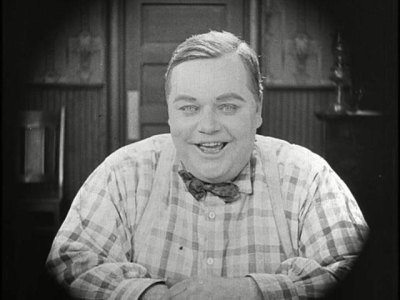
Of large build, yet surprisingly spry and able to take a fall, Roscoe obtained the nickname "Fatty" and was soon staring in one-reelers at Keystone. He quickly climbed up the comedy ladder. He made 29 films in 1913, and 46 in 1914. By 1915 he had graduated to two-reelers, and was a full-fledged star.
By 1916, Fatty who had started writing and directing his own films, and was ready to leave Keystone. He was making an amazing $500 a week at Keystone, but Chaplin was making $10,000 a week plus bonuses at that time. In the spring of 1916, Arbuckle took a trip to New York, where he met producer Joe Schenck (husband of silent movie star Norma Talmadge.) Schenck, who produced his wives movies, was looking to expand his operation. In Arbuckle, he saw a good opportunity. Arbuckle was offered $365,000 a year plus 25% of his movies profits. In addition, he would have his own production company, the Comique Film Corporation, and, most importantly, complete creative control. For this, he had to make 8 two-reelers a year. Fatty agreed, and the two men shook hands. After the shake, Roscoe found himself holding a small piece of metal, the key to a Rolls Royce, his signing bonus.
Just as he was starting his first Comique films in New York, Fatty bumped into a vaudeville comic that he had seen and admired: Buster Keaton. The two got talking, and Arbuckle asked Keaton if he'd like to be in a scene in his new film. Keaton, who had never been in a movie studio before, agreed. The next day Keaton showed up at the studio, and did a short bit where he bought some molasses from Fatty. Keaton then sped to his agent's office where he tore up a $250 per week contract to appear in a Broadway show, so that he could join Arbuckle's group at $40 a week. (The Arbuckle and Keaton shorts have been released earlier, and they are reviewed here and here.)
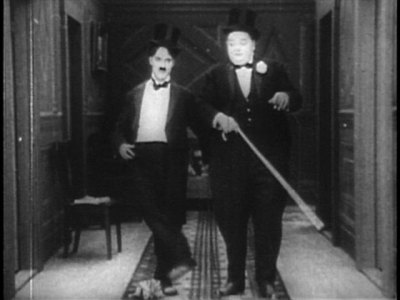 Based on the success of the Comique shorts, Paramount gave Arbuckle a contract to make feature comedy films in 1920. For the rest of 1920 and through most of 1921, Arbuckle made nine feature films, all of which did well. He was making a million dollars a year, and his popularity was rivaled only by that of his friend Charlie Chaplin.
Based on the success of the Comique shorts, Paramount gave Arbuckle a contract to make feature comedy films in 1920. For the rest of 1920 and through most of 1921, Arbuckle made nine feature films, all of which did well. He was making a million dollars a year, and his popularity was rivaled only by that of his friend Charlie Chaplin.
All this would come screeching to a halt though on Labor Day 1921. Roscoe and some friends rented some rooms in San Francisco and held a big party. Sometime during the event, some women crashed it. One of them, an out of work actress Virginia Rappe, went into a bedroom to lay down. Some people claimed that Arbuckle was in the room with her alone. In any case, the young girl died of a ruptured bladder. The Hearst newspapers had a field day with the story, painting Arbuckle as a rapist and a murderer. Some of the more salacious articles implied that he was too fat to function normally, and frustrated by that fact, raped the woman with a bottle.
This was Hollywood's first major scandal. People were up in arms and Hollywood was scared. Arbuckle was tried three times, the first two juries ending up deadlocked. One April 8th, 1921, the third jury took only ten minutes to find Arbuckle innocent of all charges. The jury even apologized to Arbuckle. It was too little too late though, his career was in ruins. (It is now generally accepted that Rappe died from a botched abortion.)
Many state censor boards banned the showing of Arbuckle's films. William Hays, hired to lead a watch-dog group to police the ethics and morals of films coming out of the studios, banned Arbuckle from appearing in films. He did this ten days after the comedian was acquitted.
Because his films couldn't even be shown legally in many places, no one thought that they were worth saving. While Chaplin, Pickford, and Lloyd all had the money to ensure that their movies would be preserved, Arbuckle had spent most of his money on attorneys. (He had to sell his home and collection of cars to pay the lawyer's bills.) Consequently, Arbuckle's films were burned or thrown away when store rooms became too full. With his films rare and hard to see, his reputation was eclipsed by other silent comedians, and he was all but forgotten.
The DVD set:
Thanks to a new collection of Arbuckle films from Laughsmith Entertainment and Mackinac Media, it is now much easier to evaluate this comedian's legacy. The aptly named Forgotten Films of Roscoe "Fatty" Arbuckle is a wonderful four disc set that brings together 30 of this comedians films (with one film presented twice in different forms.) This set covers Arbuckle's complete career, from the early Keystone days, where Arbuckle was learning the craft of making comic films and proceeds through some of his early directorial efforts, to shorts he made with his own production company. A feature film he made at Paramount is also included. This remarkable set doesn't stop there though. After his career ending scandal, Roscoe continued to work behind the camera directing under the pseudonym William B. Goodrich. Several of these rarely seen shorts are presented too.
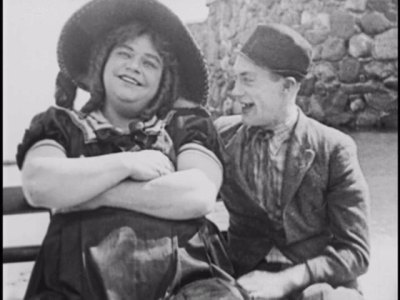 The films are arranged in chronological order, so you can see how Arbuckle's style and type of comedy evolve over time. It is also interesting to note that there were some traits that stayed the same. Roscoe didn't have a single character that he used in all of his films like Chaplin's Tramp, but there were some manners that just about all of his characters had. They all possessed a natural innocence, even when they were getting into trouble. The audience was always rooting for Roscoe, he had an 'everyman' quality that people could relate to. Its easy to laugh at Chaplin's creativity, or worry for Lloyd's safety, but viewers laughed with Arbuckle because they could relate to him. The hen-pecked husband or the man who lets his eye stray when an attractive woman walks by are things that most people could identify with. When Roscoe took things a step further than most people would, and ended up paying for it usually, the audience would laugh and say "oh yeah, that's why I don't act that way." (It wouldn't be too far of a stretch to say that he was sort of a very early version of George Costanza from Seinfeld in a lot of ways.)
The films are arranged in chronological order, so you can see how Arbuckle's style and type of comedy evolve over time. It is also interesting to note that there were some traits that stayed the same. Roscoe didn't have a single character that he used in all of his films like Chaplin's Tramp, but there were some manners that just about all of his characters had. They all possessed a natural innocence, even when they were getting into trouble. The audience was always rooting for Roscoe, he had an 'everyman' quality that people could relate to. Its easy to laugh at Chaplin's creativity, or worry for Lloyd's safety, but viewers laughed with Arbuckle because they could relate to him. The hen-pecked husband or the man who lets his eye stray when an attractive woman walks by are things that most people could identify with. When Roscoe took things a step further than most people would, and ended up paying for it usually, the audience would laugh and say "oh yeah, that's why I don't act that way." (It wouldn't be too far of a stretch to say that he was sort of a very early version of George Costanza from Seinfeld in a lot of ways.)
Another trait that stayed with him through his career is that Arbuckle would never use his weight to get a laugh, which is fairly odd for the time. He never sat on a chair only to have it break, or got stuck in a doorway. These would be easy jokes, but they would quickly grow old. There were several times when his bulk would translate into great strength though. In The Knockout several cops manage to lasso a fleeing Roscoe and he pulls them along as if they were nothing, and eventually picks up the rope and swings them around and around, just to give one example.
The set starts out with some of Roscoe's earliest starring roles at Keystone. These films, like most of Keystone's product, are fast and furious, leaving little room for plot. One of Arbuckle's best 'typical Keystone' pictures is The Rounders which co-starred and was directed by Charlie Chaplin. Chaplin and Arbuckle are a pair of drunks who live across the hall from each other and come home one evening to their irate spouses. The wives yell at their husbands, and eventually each other. This gives the boys a chance to sneak some money from their better halves purses, so they can continue carousing. Chaplin and Arbuckle play expertly off each other with great comic effect. Their acrobatic stunts are more than just prat falls, more like a ballet as the two twirl around each other (and their wives) and stagger in unison. You can tell that more thought went into this short than the average Keystone picture. Chaplin and Arbuckle both wanted to do more sophisticated humor, but with this picture they proved that they could do slapstick better than anyone else at the time.
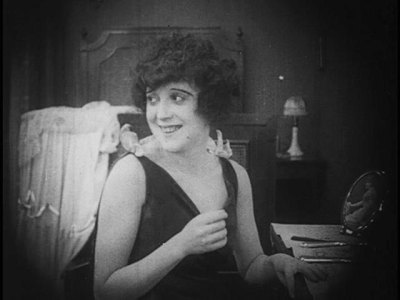 There are several films in this set that Roscoe made with the Mabel Normand, another popular comic of the time who is now largely forgotten. (Mabel was voted the best female comedian in Motion Picture World's 1915 popularity contest. Other winners were Charlie Chaplin for best male comedian and Mary Pickford for best female actress.) Their Keystone pictures are also full of action but are a little more sophisticated, taking a little more time to set up the situations. Fatty and Mabel's Simple Life (1915) is a favorite of mine. This comedy has Roscoe working on a farm for Mabel's dad. Though the two are in love, Mabel's father wants her to marry the son of the person who holds the mortgage on their farm. If she does, he'll forgive the loan. Mabel has no intention of doing that though, and tries to elope with her beau, which ends in one of Keystone's funnier chase scenes. Maybe it's the farm setting but I laugh every time I see this short.
There are several films in this set that Roscoe made with the Mabel Normand, another popular comic of the time who is now largely forgotten. (Mabel was voted the best female comedian in Motion Picture World's 1915 popularity contest. Other winners were Charlie Chaplin for best male comedian and Mary Pickford for best female actress.) Their Keystone pictures are also full of action but are a little more sophisticated, taking a little more time to set up the situations. Fatty and Mabel's Simple Life (1915) is a favorite of mine. This comedy has Roscoe working on a farm for Mabel's dad. Though the two are in love, Mabel's father wants her to marry the son of the person who holds the mortgage on their farm. If she does, he'll forgive the loan. Mabel has no intention of doing that though, and tries to elope with her beau, which ends in one of Keystone's funnier chase scenes. Maybe it's the farm setting but I laugh every time I see this short.
Mack Sennett, the owner of Keystone, had a narrow vision when it came to what he thought would be funny. He didn't want situational comedy or comedy that was in any way subtle or thoughtful, he made slapstick and that's what he wanted from his stars. Mabel Normand and Roscoe were growing tired of this type of film and wanted to make something different. Together they went off to New York and made, for Keystone, a trio of very funny films. The two that survive are among the best films that they made for Sennett. Included with this set is He Did and He Didn't. A more refined film where the comedy largely comes from the situations that Mabel and Roscoe find themselves in, rather than falls and sight gags. (It is too bad that Fatty and Mabel Adrift, the other classic film made when they were on the east coast wasn't also included.)
It should also be mentioned that Roscoe and his cousin and frequent co-star Al St. John reproduced one of the Keaton's vaudeville routines in The Waiter's Ball, which is included with this set. At one point the two comedians start taking turns hitting each other with brooms, a bit that was lifted from Keaton's family's act. This was before Roscoe and Buster ever met. Buster's father, Joe, was apparently livid when he heard about it since he had refused several offers to film their act. Arbuckle later expanded the gag into a three way slug-fest in the film Love, which is also included in this collection.
One of the interesting things to note in about Arbuckle's films is how he starts to incorporate more and more everyday items in his films for comic effect. He was an expert at prop oriented comedy, some of it very simple yet effective. In The Waiter's Ball, for example, Roscoe is a cook who has a large pot with a spigot at the bottom simmering on his stove. When ever someone orders something, he'll turn the spigot and out will come the order, be it soup, coffee, or even ice cream. This is a more refined style comedy, where the audience has to pay a little more attention to what is going on in order to catch the joke. Though Sennett didn't like this sort of joke, Arbuckle knew just how to set it up and deliver it.
The more control Arbuckle had over the films he starred in, the better the were, generally. A pair of Arbuckle's Comique films, where he had total control, are presented in this set including the 'lost' film Love. This film was painstakingly pieced together from two incomplete prints that were tracked down by restoration director Paul Gierucki. This is one of the best looking films of the set. A very funny movie, with a lot of nonsensical gags that just work really well, in addition to some funny slapstick. I loved Roscoe driving around in Ford's "economy model." A wonderful short that has been lovingly (no pun intended) restored.
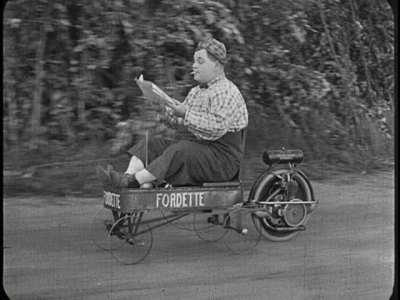
The set doesn't stop there though. Also included is a feature film Arbuckle did for Paramount, Leap Year. This nearly hour long film was made just before the Labor Day party that would ruin Arbuckle's career, and was never released in the US. This light situational comedy is a drastic departure from the shorts Roscoe was doing five or six years earlier. The humor isn't as crass, and it doesn't rely on slapstick and chases to get laughs. The humor is more character driven and works very well. In a lot of ways it is reminiscent of Buster Keaton's first feature film, The Saphead, which is more of a drawing room comedy than slapstick mayhem. It is a film that is very sophisticated for its age, it shows how versatile Arbuckle was. He wasn't limited to only doing prat falls and slapstick gags. He was great at those, but he was also very good at other forms of comedy, as this film illustrates.
The set is rounded out by five films that Arbuckle directed after the scandal. These movies he made for Educational Films include films starring Al St. John, Lloyd Hamilton, and Lupino Lane among others. They are well crafted and executed works, and shows that Arbuckle knew how to present a joke. His contributions to these films were just as great as the comedians he was filming.
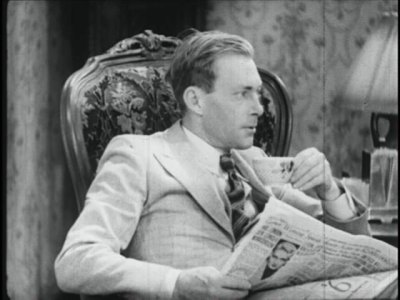 |
| |
Many people have wondered over the years what else Arbuckle might have done had his acting career not been cut so short. After watching this set, I found myself wondering how history would have judged him if more of his films had survived and been shown over the years. From this cross section of his career, it is obvious that Arbuckle hasn't gotten the attention that he deserves. Being unjustly banned from films and censored both in the US and abroad caused his films to be rarely shown while those of Keaton, Chaplin and Lloyd were more readily accessible. Because of this, when people talk of the masters of silent comedy, Arbuckle is often left out through sheer ignorance. Hopefully this excellent set will remedy these injustices, and Roscoe Arbuckle will become recognized as a talented and creative artist.
The films included in this set are as follows:
Disc One
1. Fatty Joins the Force 1913
2. A Flirt's Mistake * 1914
3. The Knockout 1914 with a cameo by Charlie Chaplin
4. The Rounders 1914 co-staring Charlie Chaplin
5. Leading Lizzie Astray * 1914
6. Mabel and Fatty's Wash Day 1915
7. Fatty and Mabel's Simple Life 1915
8. Fatty and Mabel At The San Diego Exposition 1915.
9. Fatty's New Role 1915
Disc Two
10. Mabel and Fatty's Married Life 1915
11. Fatty's Reckless Fling 1915
12. Fatty's Chance Acquaintance 1915
13. That Little Band Of Gold 1915
14. Fatty's Faithful Fido 1915
15. When Love Took Wings 1915
16. Wished On Mabel * 1915
17. Mabel's Wilful Way 1915
18. Fatty's Plucky Pup 1915
Disc Three
19. Fatty's Tintype Tangle 1915
20. He Did and He Didn't 1916 (fully tintied)
21. He Did and He Didn't 1916 (night scenes only tinted)
22. The Waiters' Ball * 1916
23. Coney Island 1917
24. Love 1919
Disc Four
25. Leap Year * 1922.
26. Character Studies ** 1925
Arbuckle as director --
27. Curses 1925
28. The Movies 1925
29. My Stars 1926
30. Fool's Luck 1926
31. Bridge Wives * 1932
* Secondary audio commentary track by Steve Massa, Bruce Lawton, and Paul Gierucki.
** Secondary audio commentary track by Richard Roberts
The DVD:
These 31 movies are presented on four DVDs which are housed in a double wide four disc keepcase. (It is the type with pages, not the kind that houses one DVD on top of the other one.) Each disc has a "Play All" option, or a sub menu listing the individual movies. This movie selection menus are a little unwieldy; each movie is represented by a one-sheet type poster displayed on a brick wall. The problem is that there are only two movies per screen, so if you are looking for the ninth film, you have to cursor through four other screens first. This is a minor complaint though.
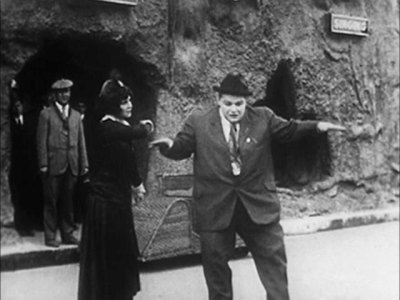
Audio:
These films are all presented with musical accompaniment. There were a large number of very talented musicians who worked on this project, and the musical performances range from small orchestras and solo piano. In all cases the music was composed for the film and is scene specific.
The quality of these recent recordings is very good. The audio track has good range and sounds very clean and clear. There are no audio defects worth noting.
Video:
As Paul Gierucki, the restoration director for this set notes in his written introduction, the Arbuckle films are really in a horrible state of preservation. The earliest films in this collection are over 90 years old, and they have all been neglected for decades. The fact that they exist at all in any state is a small miracle. Several of the movies included with this set came from reduction prints, some from multiple incomplete positive prints that had to be reconstructed and pieced together, paper prints located in the Library of Congress (these are strips of paper with each frame of the film reproduced as a positive image. They were used to secure copyrights without giving anyone the ability to duplicate the film.) were used, and occasionally the movies came from 35 mm negatives.
The quality of the video varies from film to film but overall these shorts look about average for silent movies. They are not crystal clear copies from pristine prints, but they are not faded, torn and blurry transfers either. The images are easy on the eyes generally, though most of the prints did have some damage to them. Scratches and spots of dirt are common, with missing frames being less so. Contrast varies a bit, with the best examples looking excellent, but some examples do have rather low contrast. Blooming and details disappearing in shadows and dark areas also occur.
Having said all that, I am very happy with the video quality of this collection. They are all watchable with none of the prints being in such bad shape that it detracted from the comedy on screen. The detail was good enough to catch the comical expressions on the actors faces and image was clear enough to see all the gags without straining. I have seen much worse examples of silent films than these. Given their rare nature and age, I think they look fantastic.
Extras:
The extras that are presented on the discs are fairly minimal. Disc one has a selection of 19 line drawings of Fatty by Tom Bertino, and disc four has The Arbuckle Shuffle, a three minute compilation of Roscoe's falls, stunts and flourishes from his movies set to music. This last item was fun to watch.
Several of the films also have audio commentaries by Steve Massa, Bruce Lawton, and Paul Gierucki. I enjoyed all of these, finding them fun to listen too and informative. It is obvious this trio enjoys Arbuckle's films and their enthusiam for the subject matter comes through in these tracks. In addition to giving background on the star, they also identify the supporting, and even background, characters in some instances along with giving brief biographies of the actors. I was particularly impressed with their identification of the man playing the Sheik in A Flirt's Mistake. Watch the film without the commentary and see if you can figure out who it is. I didn't.
The bonus item that I was most impressed with was the 36 page booklet that is included with the set. This glossy pamplet has articles by several film historians on all aspects of Arbuckle's career. Paul Gierucki, the restoration director for this set, writes a very informative piece about the lengths that they had to go to in order to restore some of the films in this collection, and Steve Massa has a very interesting piece on Arbuckle's later career as a director. There are also essays on Roscoe's relationship with Buster Keaton, and on his early days at Keystone. Though I don't agree with the assertion, made by one author, that most people believe that Arbuckle was guilty of the crimes he was tried for, the other articles were very informative and well researched. (I have yet to meet a single person who thinks that Arbuckle was guilty, or read an article written in the last fifty years that doesn't mention his innocence.) This booklet is a great piece of bonus material and I'm glad that Laughsmith went to the trouble to include it.
Final Thoughts:
This is a truly amazing collection. Roscoe "Fatty" Arbuckle was a comedy giant in the early days of film, but is now almost forgotten. Only a few of his films have previously been available in quality versions on DVD, most notably his films with Buster Keaton, and this set fills a gap that is long overdue. The collection gives a good overview of Arbuckle's career, from his first days at Keystone to his million dollar a year contract with Paramount to make feature films. Even beyond that, there is a nice selection of films that he wrote and directed when he was unemployable as an actor. But what is even more important is that these films are just down right funny. Arbuckle, especially in his later films, creates comic flourishes, flipping a knife behind his back and having it land point first in a butcher block for example, and makes it look easy and natural. This set presents a fantastic overview of this multi-talented comedian. This collection should be in every silent movie fan's DVD collection. This set is assuredly belongs in the DVD Talk Collector Series.
|
| Popular Reviews |
| Sponsored Links |
|
|
| Sponsored Links |
|
|
| Release List | Reviews | Shop | Newsletter | Forum | DVD Giveaways | Blu-Ray | Advertise |
|
Copyright 2024 DVDTalk.com All Rights Reserved. Legal Info, Privacy Policy, Terms of Use,
Manage Preferences,
Your Privacy Choices | |||||||














